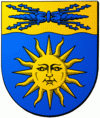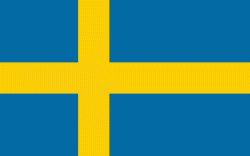Skellefteå
 |
The city is historically industrial, with mining being a large part of that industry, especially for gold, leading to the city being nicknamed Guldstaden ("gold town"). Politically, Skellefteå is a Social Democratic stronghold. The city is a well-known ice hockey town, with its main team Skellefteå AIK playing in the Swedish top division: the SHL, which they have won on several occasions; most recently in 2014.
The city was incorporated in 1845 and grew to its current population size in the 1950s and 1960s, growing only slowly since. It is the second largest city in Västerbotten after Umeå and is located roughly halfway between it and Luleå. The Skellefte River passes through the city and it is located around 15 km from the Bothnian Bay open sea. Skellefteå is served by Skellefteå Airport, IATA airport code SFT but locally known as Falmark because of the village nearby, also around 15 km from the city centre to the south.
The name Skellefteå is recorded to having been spelled as Skelepht in 1327. On Carta marina the name is spelt Skellitta. The origin of the name remains unknown, but is assumed to be of Sami origin.
From the 14th century on, attempts were made to Christianize Skellefteå. A parish was formed and a church built. However, for the most part, the entire large Northern Swedish territory of Norrland was not Christianized until several hundred years after the rest of Sweden, and many northern areas such as Skellefteå remained unexplored well past the Middle Ages.
Not before the very end of the 17th century did the indigenous Sami people of Northern Sweden begin turning to Christianity, much due to the efforts by the Northern Swedish superintendent Mathias Steuchius, who worked hard to accomplish this. Several Sami priests were killed for this reason.
Eventually, the reason for the sudden awakened interest towards Skellefteälven and the surrounding areas was the great northern fishing grounds of salmon. The increased demand for fish was sparked by a stricter enforcement of the annual month-long fasting by the Catholic Church, whereby meat was substituted by fish.
The actual city of Skellefteå is one of the youngest cities of Norrland. It was founded in 1845 by the vicar Nils Nordlander.
Map - Skellefteå
Map
Country - Sweden
 |
 |
| Flag of Sweden | |
Nature in Sweden is dominated by forests and many lakes, including some of the largest in Europe. Many long rivers run from the Scandes range through the landscape, primarily emptying into the northern tributaries of the Baltic Sea. It has an extensive coastline and most of the population lives near a major body of water. With the country ranging from 55°N to 69°N, the climate of Sweden is diverse due to the length of the country. The usual conditions are mild for the latitudes with a maritime south, continental centre and subarctic north. Snow cover is infrequent in the densely populated south, but reliable in higher latitudes. Furthermore, the rain shadow of the Scandes results in quite dry winters and sunny summers in much of the country.
Currency / Language
| ISO | Currency | Symbol | Significant figures |
|---|---|---|---|
| SEK | Swedish krona | kr | 2 |
| ISO | Language |
|---|---|
| FI | Finnish language |
| SE | Northern Sami |
| SV | Swedish language |















